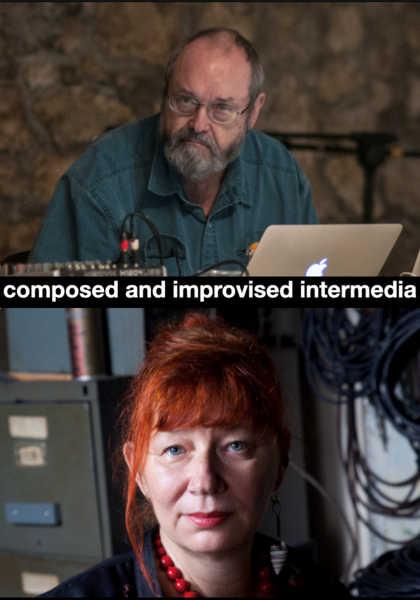Phill Niblock (1933) is a New York-based minimalist composer and multi-media musician and director of Experimental Intermedia, a foundation born in the flames of 1968’s barricade-hopping. He has been a maverick presence on the fringes of the avant garde ever since. In the history books Niblock is the forgotten Minimalist. That’s as maybe: no one ever said the history books were infallible anyway.
His influence has had more impact on younger composers such as Susan Stenger, Lois V Vierk, David First, and Glenn Branca. He’s even worked with Sonic Youth’s Thurston Moore and Lee Renaldo on “Guitar two, for four” which is actually for five guitarists. This is Minimalism in the classic sense of the word, if that makes sense. Niblock constructs big 24-track digitally-processed monolithic microtonal drones. The result is sound without melody or rhythm. Movement is slow, geologically slow. Changes are almost imperceptible, and his music has a tendency of creeping up on you. The vocal pieces are like some of Ligeti’s choral works, but a little more phased. And this isn’t choral work. “A Y U (as yet untitled)” is sampled from just one voice, the baritone Thomas Buckner. The results are pitch shifted and processed intense drones, one live and one studio edited. Unlike Ligeti, this isn’t just for voice or hurdy gurdy. Like Stockhausen’s electronic pieces, Musique Concrete, or even Fripp and Eno’s No Pussyfooting, the role of the producer/composer in “Hurdy Hurry” and “A Y U” is just as important as the role of the performer. He says: “What I am doing with my music is to produce something without rhythm or melody, by using many microtones that cause movements very, very slowly.” The stills in the booklet are from slides taken in China, while Niblock was making films which are painstaking studies of manual labour, giving a poetic dignity to sheer gruelling slog of fishermen at work, rice-planters, log-splitters, water-hole dredgers and other back-breaking toilers. Since 1968 Phill has also put on over 1000 concerts in his loft space, including Ryoji Ikeda, Zbigniew Karkowski, Jim O’Rourke.
Phill Niblock (b. 1933, USA) is an artist whose fifty-year career spans minimalist and experimental music, film and photography. Since 1985, he has served as director of Experimental Intermedia, a foundation for avant-garde music based in New York with a branch in Ghent, and curator of the foundation’s record label XI. Known for his thick, loud drones of music, Niblock’s signature sound is filled with microtones of instrumental timbres that generate many other tones in the performance space. In 2013, his diverse artistic career was the subject of a retrospective realised in partnership between Circuit (Contemporary Art Centre Lausanne) and Musée de l’Elysée. The following year Niblock was honoured with the prestigious Foundation for Contemporary Arts John Cage Award.
Katherine Liberovskaya (1961) is a video and media artist based in Montreal, Canada, and New York City. She has been working predominantly in experimental video since the late eighties. Over the years, she has produced many single-channel videos, video installation works and video performances which have been presented at a wide variety of artistic venues and events around the world. As of recent years her work - in single-channel and installation video as well as performance - mainly revolves around collaborations with new music composers/sound artists, notably Phill Niblock, Al Margolis/If,Bwana, Hitoshi Kojo, Zanana, Anne Wellmer, David First and David Watson.
Since 2003 she is active in live video mixing exploring improvisation with numerous live new music/audio artists including: Margarida Garcia, Barry Weisblat, o.blaat, murmer, André Gonçalves, Monique Buzzarté, Anthony Coleman, Shelley Hirsch, Giuseppe Ielasi, Renato Rinaldi, Audrey Chen, among many others. In addition to her art practice she has concurrently been involved in the programming and organization of diverse media art events, notably with Studio XX in Montreal (programming coordinator 1996-1998, president 2001-2003), Espace Vidéographe, Montreal and Experimental Intermedia, NY (Screen Compositions 2005, 2006, 2007, 2008) as well as the OptoSonic Tea series with Ursula Scherrer at Diapason in NYC and in various locations in Europe and elsewhere with OptoSonic Tea On the Road.
